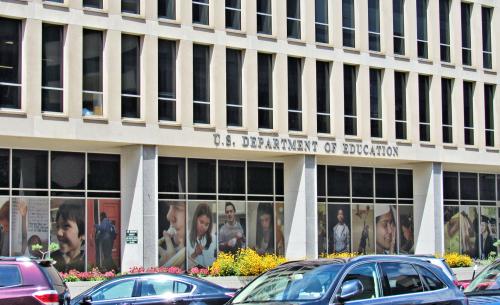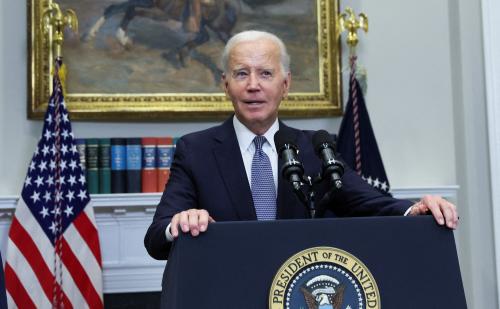A version of this post appeared on WSJ.com.
The U.S. Department of Education is opening what could be a very large (and, for taxpayers, expensive) door to debt relief. As the department ponders its standard for forgiving loans, potentially tens of thousands of borrowers could seek relief from repaying tens of billions of dollars in debt.
Student loans are a high-profile issue. Many borrowers have compelling stories: They borrowed to attend classes that didn’t pay off in terms of jobs or higher wages and are stuck with loans that can’t be discharged in bankruptcy. For-profit colleges account for a disproportionate share of loan defaults. Several Democrats in Congress–Sen. Elizabeth Warren (Mass.) among them–are pushing the administration to use a federal regulatory provision to forgive lots of loans. Other lawmakers, many of them Republican, see this as another unwarranted Obama administration assault on the for-profit college industry.
So far, blanket debt relief has been offered only to students at affiliates of Corinthian Colleges Inc., a large for-profit chain that filed last month for bankruptcy-court protection. About 15,000 Corinthian students with a combined $200 million in loans who were attending schools that were closed are eligible for debt relief under a well-understood federal loan provision that covers shuttered schools.
But there’s a long-ignored federal regulation, known as “defense to repayment,” that allows borrowers to seek loan forgiveness in the case of “any act or omission of the school attended by the student that would give rise to a cause of action against the school under applicable state law,” such as bans on unfair and deceptive practices. Until recently, this clause had been invoked only five times–ever.
Citing that regulation, the Education Department is offering debt forgiveness to students who enrolled in programs at Corinthian’s Heald College for which the school, according to the government, published grossly misleading job-placement rates. About 50,000 Heald students borrowed $680 million; most were in programs for which misleading data were posted and thus are eligible for debt forgiveness.
But the Education Department isn’t stopping at Corinthian–and that’s where the numbers could get big. “If you’ve been defrauded by a school, we’ll make sure that you get every penny of the debt relief you are entitled to through a streamlined process,” Education Secretary Arne Duncan said in a recent call with reporters. The department plans to name a special master to “help develop a broader system that will support students at other institutions who believe they have a defense to repayment.”
There could be a lot of other institutions. At least 28 colleges, mostly for-profit, are under investigation, according to their Securities and Exchange Commission filings or to state and local government authorities.
Tabulating data from the Education Department’s public database, Hutchins Center finds that students who attended those 28 colleges have borrowed more than $57 billion between school year 2009-10 and the first nine months of 2014-15. Even in Washington, that’s a lot of money.
To be clear: An investigation doesn’t mean that a school has been found to have done anything wrong. And even if the Education Department concludes that there has been wrongdoing, not every student at that school would be eligible for debt relief, and not every eligible student would seek relief. Also, Education Department regulations allow the government to go after the colleges for the money (if the colleges have any left).
Here are the 28 schools with links to their SEC filings or other information on local, state or federal investigations.
|
Name |
Loans Made ($) |
Total Number Loans* |
|
|
14,600,000,000 |
6,053,570 |
||
|
8,580,000,000 |
4,386,035 |
||
|
6,970,000,000 |
4,277,682 |
||
|
5,310,000,000 |
3,041,179 |
||
|
5,050,000,000 |
3,413,640 |
||
|
4,430,000,000 |
3,058,516 |
||
|
3,880,000,000 |
1,460,380 |
||
|
3,000,000,000 |
2,080,180 |
||
|
1,360,000,000 |
636,048 |
||
|
1,090,000,000 |
704,640 |
||
|
925,000,000 |
603,100 |
||
|
453,000,000 |
277,014 |
||
|
356,000,000 |
159,140 |
||
|
354,000,000 |
281,803 |
||
|
235,000,000 |
167,629 |
||
|
179,000,000 |
136,219 |
||
|
178,000,000 |
137,197 |
||
|
150,000,000 |
96,725 |
||
|
87,100,000 |
53,542 |
||
|
66,900,000 |
45,687 |
||
|
42,100,000 |
29,401 |
||
|
40,400,000 |
19,381 |
||
|
32,900,000 |
22,023 |
||
|
18,400,000 |
10,206 |
||
|
16,400,000 |
9,996 |
||
|
15,300,000 |
12,988 |
||
|
14,900,000 |
9,994 |
||
|
14,200,000 |
9,566 |
||
* An individual may have more than one loan
** New York City Department of Consumer Affairs confirms it has subpoenaed these colleges
***Anamarc College closed in June 2014
Source: Brookings Institution’s Hutchins Center on Fiscal & Monetary Policy analysis of Title IV Program Volume Reports from 2009-10 through third quarter of 2014-15.
The “defense to repayment” regulation gives the department substantial flexibility: It doesn’t have to wait for a state to determine that a college broke the law to waive a student’s loans. Among the special master’s jobs will be to recommend an evidentiary standard for considering students’ requests, recognizing that the first few cases will inevitably set precedents. The more generous the reading of the regulation, the more borrowers likely to seek relief.
Forgiving student loans in this fashion doesn’t require an act of Congress or formal approval from the Treasury or the Office of Management and Budget–even if forgiveness means that future government receipts will be lower and budget deficits larger than projected. The Education Department has no reliable way of estimating the cost of its actions because there is so little history to go by. Earlier this year, the president’s budget disclosed that past Obama administration student-loan debt-relief initiatives reduced projected repayments by $21.8 billion.
All this involves past borrowing. Meanwhile, the Obama administration is running into congressional resistance to its proposals to tighten regulation of higher education going forward, with some accusing the administration of regulatory overreach. A spending bill unveiled in the House Appropriations Committee this week, for instance, would block the Education Department from moving forward with proposed rules.
“We’re going to continue to try to do the right thing for students and taxpayers,” Secretary Duncan has said. “But hopefully Congress will wake up here and get members on both sides of the aisle, and figure out that they need to strengthen our hand in dealing with these guys.”









Commentary
Op-edLots riding on Ed Dept standard for student-loan forgiveness
June 18, 2015